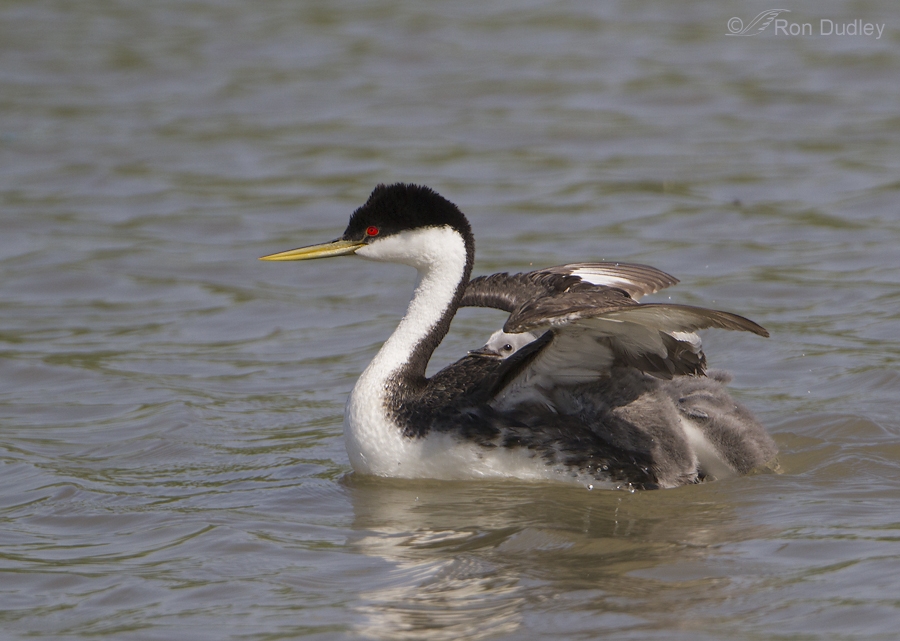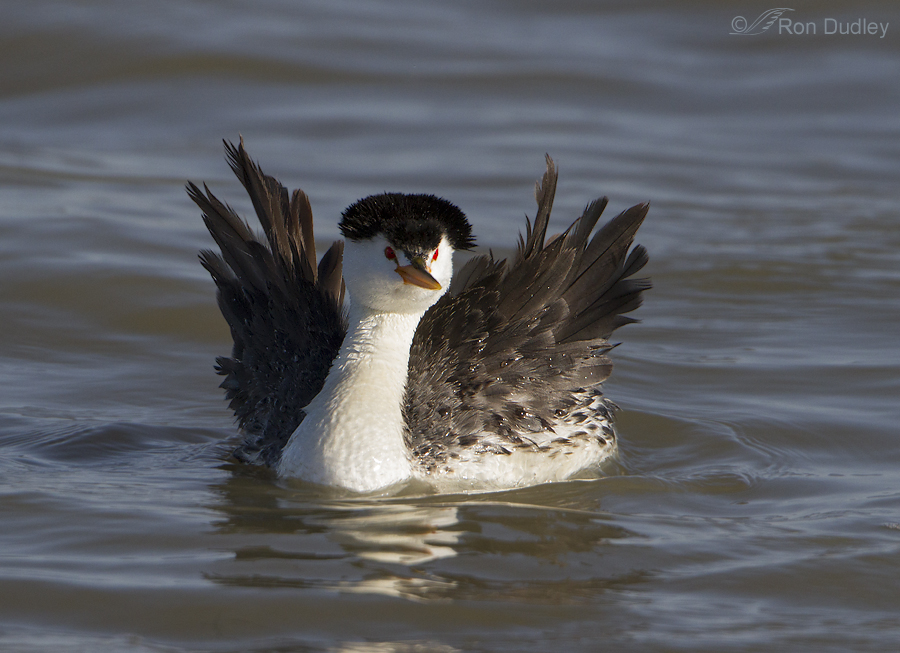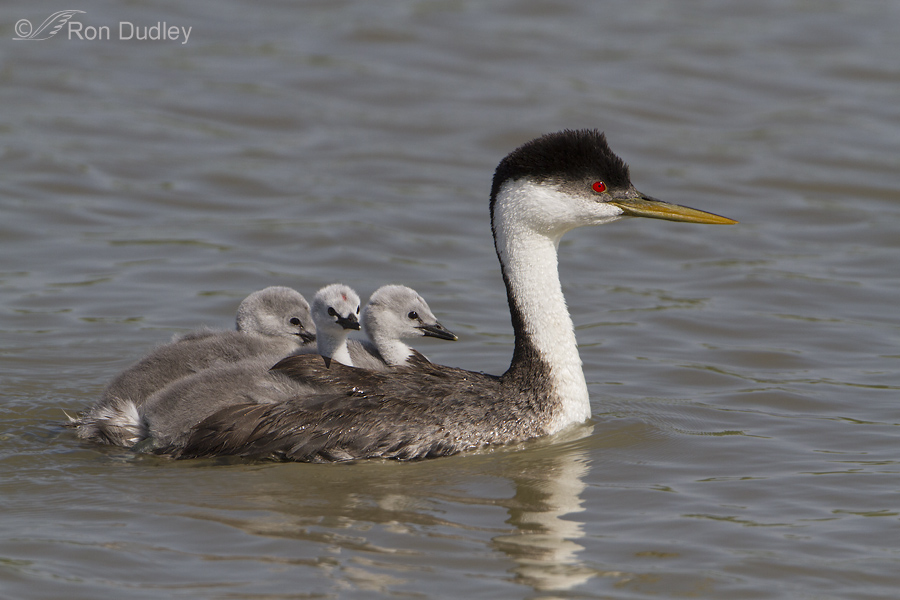Tag: back brooding
Western Grebe – Dumping The Chick Load

At this age Western Grebe chicks are heavy-bodied, small headed, loud, awkward and demanding. They alternately ride on the back of each parent (back brooding) as the other adult rests or hunts for fish to feed to its family. At this stage the youngsters are good swimmers and there’s often not enough room on the parents back for all of the chicks to ride comfortably anyway so the parent uses an interesting strategy to “dump its load” into the water when it needs a break.
Clark’s Grebe Blowin’ In The Wind

Three days ago at Bear River Migratory Bird refuge I had some wind to contend with as I was photographing this Clark’s Grebe. It made the water a little choppy and would occasionally ruffle the feathers of one of the birds when it turned its back to the breeze.
The effect varied fairly dramatically.
Clark’s Grebes – Parents Feeding Fish To Some Very Excited Chicks
This past June I spent lots of time with Western and Clark’s Grebes as they were raising their families. The two species are quite similar but the adult birds in this post can be recognized as Clark’s Grebes by their bright yellow-orange bills and the fact that their eyes are surrounded by white plumage, rather than black. 1/2000. f/7.1, ISO 500, 500 f/4, 1.4 tc, natural light This female of a mated pair was fishing for her family as the male back-brooded two chicks (the sexes take turns with each role). I happened to catch her just as she emerged from the water with a fish and shook the water off. I wish I had better eye contact and more room around the grebe, but this image is full frame. I include it here because it’s the logical beginning of this “fish story”. 1/2000. f/8, ISO 500, 500 f/4, 1.4 tc, natural light Seconds later she swam over to deliver the fish to her family. Sometimes the fish will be given to the brooding parent, who may eat it or give it to a chick. Other times, the fishing parent gives it directly to one of the youngsters. Either way, if the chicks are hungry they become very excited and aggressive in their attempts to be the one who gets the fish. Before the young birds saw breakfast coming their way, they were tucked down peacefully under each wing with only their heads and necks sticking out. All that changed in an instant. 1/2000….
Western Grebe Chick Reacts To Food
I’ve always enjoyed spending time with Western Grebes but until this past summer I’ve had very little success in photographing parents back-brooding their chicks. In June at Bear River Migratory Bird Refuge my luck with this behavior changed and I was able to get quite a few nice images of the chicks on the backs of the parents over many days. Here, two chicks wait patiently on the back of one of the parents while the other one attempts to catch fish for breakfast. The fishing parent would feed small fish to both chicks and to the brooding parent. The chicks watch attentively for the adult to emerge from the nearby water with something to eat. I was always torn about what to photograph – the parent with the fish or the reactions of the chicks to approaching food. In this case I chose the latter. Here, the chick on the right has just spotted its parent come up out of the water from behind with a small fish and is beginning to react. Usually, both chicks were hungry and competed for the food but this time the youngster on the left was full and not interested in anything to eat. But the chick on the right didn’t know that and went into full competetive begging mode. I always enjoyed watching these reactions to food. Ron
Can’t We Go Any Faster Dad?
I’ll preface this post with an apology for the cutesy title. I usually avoid them at all costs but in this case I just couldn’t help myself… (I’m making the assumption that the adult bird here is the male because of its straight bill but it’s a subtle distinction and I could be wrong). For the last few days we’ve been having a great time with Clark’s and Western Grebes and their chicks. Both sexes of both species brood their chicks on their backs (back brooding) from almost the moment they hatch until they are quite large. I’ve seen up to three chicks of about this size on the back of a single adult, although by the time they get this size the other parent often shares the burden. 1/1600, f/8, ISO 400, 500 f/4, 1.4 tc When I first saw this image of a Clark’s Grebe and its chick on my screen I assumed it was simply another case of the youngster having just jumped onto the back of the adult (as evidenced by the position of the feet and the direction of the water splash). But now I’m quite convinced that the adult was actually allowing the youngster to act as an outboard motor of sorts as the chick seems to be providing the propulsion as the parent relaxes. If so, and I think it is, in all the time I’ve spent watching these birds this is the first time I’ve noticed such interesting behavior. I offer this image as further evidence of my theory…
Western Grebe – Dumping The Chick Load

At this age Western Grebe chicks are heavy-bodied, small headed, loud, awkward and demanding. They alternately ride on the back of each parent (back brooding) as the other adult rests or hunts for fish to feed to its family. At this stage the youngsters are good swimmers and there’s often not enough room on the parents back for all of the chicks to ride comfortably anyway so the parent uses an interesting strategy to “dump its load” into the water when it needs a break.
Clark’s Grebe Blowin’ In The Wind

Three days ago at Bear River Migratory Bird refuge I had some wind to contend with as I was photographing this Clark’s Grebe. It made the water a little choppy and would occasionally ruffle the feathers of one of the birds when it turned its back to the breeze.
The effect varied fairly dramatically.
Clark’s Grebes – Parents Feeding Fish To Some Very Excited Chicks
This past June I spent lots of time with Western and Clark’s Grebes as they were raising their families. The two species are quite similar but the adult birds in this post can be recognized as Clark’s Grebes by their bright yellow-orange bills and the fact that their eyes are surrounded by white plumage, rather than black. 1/2000. f/7.1, ISO 500, 500 f/4, 1.4 tc, natural light This female of a mated pair was fishing for her family as the male back-brooded two chicks (the sexes take turns with each role). I happened to catch her just as she emerged from the water with a fish and shook the water off. I wish I had better eye contact and more room around the grebe, but this image is full frame. I include it here because it’s the logical beginning of this “fish story”. 1/2000. f/8, ISO 500, 500 f/4, 1.4 tc, natural light Seconds later she swam over to deliver the fish to her family. Sometimes the fish will be given to the brooding parent, who may eat it or give it to a chick. Other times, the fishing parent gives it directly to one of the youngsters. Either way, if the chicks are hungry they become very excited and aggressive in their attempts to be the one who gets the fish. Before the young birds saw breakfast coming their way, they were tucked down peacefully under each wing with only their heads and necks sticking out. All that changed in an instant. 1/2000….
Western Grebe Chick Reacts To Food
I’ve always enjoyed spending time with Western Grebes but until this past summer I’ve had very little success in photographing parents back-brooding their chicks. In June at Bear River Migratory Bird Refuge my luck with this behavior changed and I was able to get quite a few nice images of the chicks on the backs of the parents over many days. Here, two chicks wait patiently on the back of one of the parents while the other one attempts to catch fish for breakfast. The fishing parent would feed small fish to both chicks and to the brooding parent. The chicks watch attentively for the adult to emerge from the nearby water with something to eat. I was always torn about what to photograph – the parent with the fish or the reactions of the chicks to approaching food. In this case I chose the latter. Here, the chick on the right has just spotted its parent come up out of the water from behind with a small fish and is beginning to react. Usually, both chicks were hungry and competed for the food but this time the youngster on the left was full and not interested in anything to eat. But the chick on the right didn’t know that and went into full competetive begging mode. I always enjoyed watching these reactions to food. Ron
Can’t We Go Any Faster Dad?
I’ll preface this post with an apology for the cutesy title. I usually avoid them at all costs but in this case I just couldn’t help myself… (I’m making the assumption that the adult bird here is the male because of its straight bill but it’s a subtle distinction and I could be wrong). For the last few days we’ve been having a great time with Clark’s and Western Grebes and their chicks. Both sexes of both species brood their chicks on their backs (back brooding) from almost the moment they hatch until they are quite large. I’ve seen up to three chicks of about this size on the back of a single adult, although by the time they get this size the other parent often shares the burden. 1/1600, f/8, ISO 400, 500 f/4, 1.4 tc When I first saw this image of a Clark’s Grebe and its chick on my screen I assumed it was simply another case of the youngster having just jumped onto the back of the adult (as evidenced by the position of the feet and the direction of the water splash). But now I’m quite convinced that the adult was actually allowing the youngster to act as an outboard motor of sorts as the chick seems to be providing the propulsion as the parent relaxes. If so, and I think it is, in all the time I’ve spent watching these birds this is the first time I’ve noticed such interesting behavior. I offer this image as further evidence of my theory…


